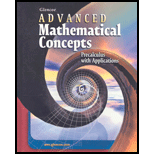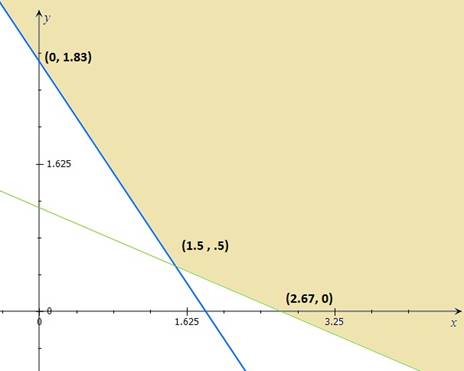
(a)
To find: The inequality to represent the ounces of protein required.
(a)
Answer to Problem 12E
The inequality is
Explanation of Solution
Given:
The given diet that includes at least 1.54 ounces of protein. Each cup of Good start puppy food contains 0.84 ounce of protein. Each cup of Sirius puppy food contains 0.56 ounce of protein.
The inequality that represent the ounces of protein required as below.
Here the amount of protein given to each cup of good start puppy food is
Therefore, the inequality is
(b)
To find: The logarithm model from the given data.
(b)
Answer to Problem 12E
The inequality is
Explanation of Solution
Given:
The given diet that includes at least 0.56 ounces of fat. Each cup of Good start puppy food contains 0.21 ounce of fat. Each cup of Sirius puppy food contains 0.49 ounce of fat.
The inequality that represent the ounces of fat required as below.
Here the amount of fat given to each cup of good start puppy food is
Therefore, the inequality is
(c)
To find: The graph the system of inequalities.
(c)
Answer to Problem 12E
The graph is given below.
Explanation of Solution
The graph of inequality is given below:

In order to check whether the shaded part contains origin or not check the following.
The shaded region does not contain origin.
Therefore the graph is given above.
(d)
To find: The function to represent the daily cost of puppy food.
(d)
Answer to Problem 12E
The function to represent the daily cost of puppy food is
Explanation of Solution
The cost of Good start puppy food is 36$ per cup.
The cost of Sirius puppy food is 22$ per cup.
So the function to represent the daily cost of puppy food is given as:
Here
And
Therefore the function to represent the daily cost of puppy food is
(e)
To find: The number of cups of each type of puppy food should be used in order to minimise the cost.
(e)
Answer to Problem 12E
The number of cups of each type of puppy:1.5 cups of Good Start and
Explanation of Solution
In order to minimise the cost, test each point in the minimizing function, that are shown on the boundary of the graph.
Further simplified as:
Although the values of the function at
Therefore there is 1.5 cups of Good Start and
(f)
To find: The minimum cost.
(f)
Answer to Problem 12E
The minimum cost is
Explanation of Solution
Calculation:
The minimum cost at
Therefore the minimum cost is
Chapter 2 Solutions
Advanced Mathematical Concepts: Precalculus with Applications, Student Edition
Additional Math Textbook Solutions
Thomas' Calculus: Early Transcendentals (14th Edition)
Calculus and Its Applications (11th Edition)
University Calculus: Early Transcendentals (3rd Edition)
Precalculus (10th Edition)
Calculus: Early Transcendentals (3rd Edition)
Calculus: Early Transcendentals (2nd Edition)
 Calculus: Early TranscendentalsCalculusISBN:9781285741550Author:James StewartPublisher:Cengage Learning
Calculus: Early TranscendentalsCalculusISBN:9781285741550Author:James StewartPublisher:Cengage Learning Thomas' Calculus (14th Edition)CalculusISBN:9780134438986Author:Joel R. Hass, Christopher E. Heil, Maurice D. WeirPublisher:PEARSON
Thomas' Calculus (14th Edition)CalculusISBN:9780134438986Author:Joel R. Hass, Christopher E. Heil, Maurice D. WeirPublisher:PEARSON Calculus: Early Transcendentals (3rd Edition)CalculusISBN:9780134763644Author:William L. Briggs, Lyle Cochran, Bernard Gillett, Eric SchulzPublisher:PEARSON
Calculus: Early Transcendentals (3rd Edition)CalculusISBN:9780134763644Author:William L. Briggs, Lyle Cochran, Bernard Gillett, Eric SchulzPublisher:PEARSON Calculus: Early TranscendentalsCalculusISBN:9781319050740Author:Jon Rogawski, Colin Adams, Robert FranzosaPublisher:W. H. Freeman
Calculus: Early TranscendentalsCalculusISBN:9781319050740Author:Jon Rogawski, Colin Adams, Robert FranzosaPublisher:W. H. Freeman
 Calculus: Early Transcendental FunctionsCalculusISBN:9781337552516Author:Ron Larson, Bruce H. EdwardsPublisher:Cengage Learning
Calculus: Early Transcendental FunctionsCalculusISBN:9781337552516Author:Ron Larson, Bruce H. EdwardsPublisher:Cengage Learning





